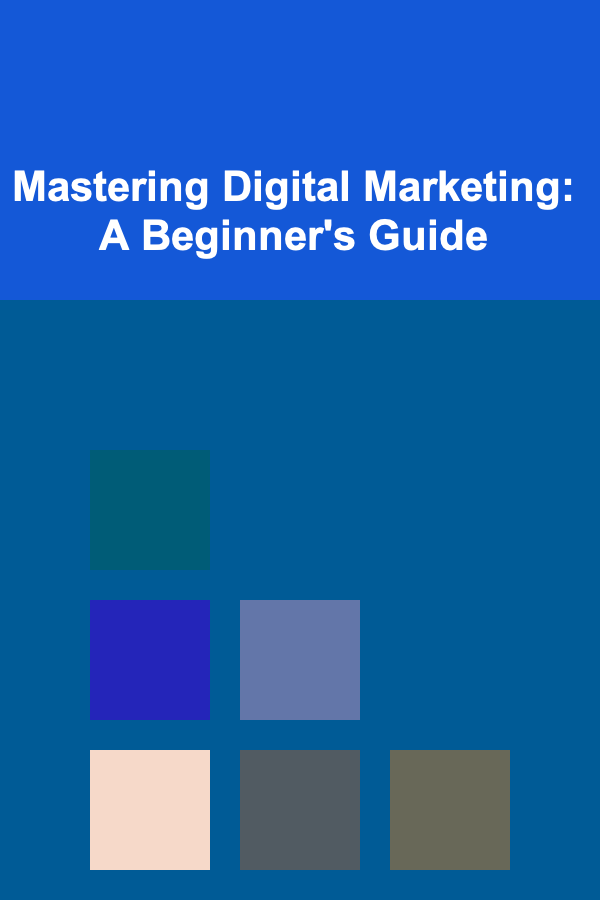
Mastering Digital Marketing: A Beginner's Guide
ebook include PDF & Audio bundle (Micro Guide)
$12.99$9.99
Limited Time Offer! Order within the next:

Digital marketing is no longer a niche discipline; it's the backbone of modern business. From startups to multinational corporations, every organization relies on digital channels to reach customers, build brand awareness, and drive revenue. However, the ever-evolving landscape of digital marketing can seem daunting for beginners. This comprehensive guide will break down the essential concepts, strategies, and tools needed to navigate the digital world and build a successful marketing career or business strategy. We'll move beyond surface-level explanations and delve into practical applications, real-world examples, and actionable steps you can take today.
Understanding the Digital Marketing Ecosystem
Before diving into specific tactics, it's crucial to understand the interconnectedness of different digital marketing channels. Think of it as a network, where each channel plays a unique role in the customer journey.
1.1. Key Channels and Their Roles
- Search Engine Optimization (SEO): SEO is about optimizing your website to rank higher in search engine results pages (SERPs) like Google, Bing, and Yahoo. It's a long-term strategy focused on organic (non-paid) visibility. Good SEO drives qualified traffic to your website from people actively searching for what you offer. It involves understanding keyword research, on-page optimization (title tags, meta descriptions, content), off-page optimization (link building, social signals), and technical SEO (site speed, mobile-friendliness). The goal is to become an authority in your niche, consistently providing valuable content that search engines recognize and reward.
- Search Engine Marketing (SEM) / Pay-Per-Click (PPC) Advertising: SEM, often used interchangeably with PPC, involves paying for ads to appear on search engine results pages. Platforms like Google Ads allow you to target specific keywords and demographics, ensuring your message reaches the right audience at the right time. While SEO is a long game, PPC provides immediate visibility and can generate quick results. It requires careful keyword research, ad copy creation, landing page optimization, and bid management to maximize your return on investment (ROI). A/B testing of ad variations and landing pages is crucial for continuous improvement.
- Social Media Marketing (SMM): SMM involves using social media platforms like Facebook, Instagram, Twitter, LinkedIn, and TikTok to connect with your target audience, build brand awareness, and drive engagement. Each platform has its own unique audience and content format, so it's essential to tailor your strategy accordingly. SMM encompasses organic posting, paid advertising, influencer marketing, community management, and social listening. It's about building relationships, fostering a sense of community, and providing valuable content that resonates with your followers. Metrics like engagement rate (likes, comments, shares), reach, and website traffic are key indicators of success.
- Content Marketing: Content marketing is the strategic creation and distribution of valuable, relevant, and consistent content to attract and retain a clearly defined audience --- and, ultimately, to drive profitable customer action. It's about providing solutions to your audience's problems, answering their questions, and building trust over time. Content formats can include blog posts, articles, ebooks, white papers, infographics, videos, podcasts, and webinars. The key is to create high-quality, engaging content that provides value and positions you as a thought leader in your industry. A well-defined content strategy aligns with your overall marketing goals and considers the entire customer journey.
- Email Marketing: Email marketing is a direct marketing channel that allows you to communicate directly with your subscribers through personalized messages. It's a highly effective way to nurture leads, promote products or services, and build customer loyalty. Building an email list requires offering valuable incentives like free ebooks, discounts, or exclusive content in exchange for email addresses. Email marketing campaigns can include welcome emails, newsletters, promotional emails, and automated email sequences (drip campaigns) triggered by specific user actions. Metrics like open rate, click-through rate, and conversion rate are crucial for optimizing your email campaigns. Compliance with email marketing regulations like GDPR and CAN-SPAM is essential.
- Affiliate Marketing: Affiliate marketing involves partnering with affiliates who promote your products or services in exchange for a commission on each sale or lead generated. It's a cost-effective way to expand your reach and tap into new audiences. Affiliate marketing requires setting up an affiliate program, recruiting relevant affiliates, providing them with marketing materials (banners, links, content), and tracking their performance. It also works in reverse, where you as a beginner could promote existing company's products, and earn commission. Building strong relationships with your affiliates is crucial for long-term success.
- Mobile Marketing: Mobile marketing encompasses a variety of strategies aimed at reaching customers on their mobile devices. This includes mobile-optimized websites, mobile advertising, SMS marketing, and app marketing. With the increasing prevalence of mobile devices, a mobile-first approach is essential for any digital marketing strategy. Understanding user behavior on mobile devices, optimizing content for smaller screens, and providing a seamless mobile experience are crucial for success.
- Influencer Marketing: Influencer marketing involves collaborating with individuals who have a significant following on social media to promote your products or services. Influencers can help you reach a wider audience, build brand awareness, and generate trust and credibility. Finding the right influencers requires identifying individuals whose audience aligns with your target market and whose values are consistent with your brand. It's crucial to establish clear expectations with influencers regarding content creation, posting schedules, and performance metrics.
1.2. The Customer Journey and Channel Integration
The customer journey is the path a customer takes from initial awareness of your brand to becoming a loyal customer. It typically involves several stages: awareness, consideration, decision, and advocacy. Effective digital marketing requires mapping out the customer journey and strategically using different channels to influence each stage.
For example:
- Awareness: Social media advertising, content marketing (blog posts, infographics), and SEO can be used to increase brand awareness and reach a wider audience.
- Consideration: Email marketing (nurturing leads with valuable content), retargeting ads (showing ads to people who have visited your website), and online reviews can be used to help potential customers evaluate your products or services.
- Decision: Landing page optimization, sales promotions, and customer testimonials can be used to encourage customers to make a purchase.
- Advocacy: Email marketing (customer loyalty programs), social media engagement (responding to customer feedback), and referral programs can be used to encourage customers to become brand advocates.
Integrating these channels is key. For example, a blog post optimized for SEO can drive traffic to a landing page where visitors can sign up for an email newsletter. This newsletter can then be used to nurture leads and promote products or services. Social media can be used to share blog posts, engage with followers, and drive traffic back to your website. The key is to create a cohesive and consistent brand experience across all channels.
Tip: Start by focusing on 2-3 key channels that are most relevant to your target audience and business goals. Don't try to do everything at once. As you gain experience and resources, you can gradually expand your efforts to other channels.
Building a Strong Foundation: Website and Analytics
Your website is the central hub of your digital marketing efforts. It's where you showcase your brand, provide information about your products or services, and convert visitors into customers. A well-designed, user-friendly website is essential for success.
2.1. Website Design and User Experience (UX)
A good website should be visually appealing, easy to navigate, and optimized for mobile devices. Key elements of website design and UX include:
- Clear and Concise Messaging: Your website should immediately communicate what you do and why visitors should choose you. Use clear and concise language that resonates with your target audience.
- Intuitive Navigation: Visitors should be able to easily find what they're looking for. Use clear and logical navigation menus, search functionality, and internal linking.
- Mobile Responsiveness: Your website should be optimized for all devices, including smartphones and tablets. A responsive design automatically adjusts to the screen size of the device being used.
- Fast Loading Speed: Slow loading times can frustrate visitors and negatively impact your search engine rankings. Optimize your images, use caching, and choose a reliable web hosting provider.
- Compelling Calls to Action (CTAs): Use clear and compelling CTAs to guide visitors towards desired actions, such as signing up for a newsletter, requesting a quote, or making a purchase.
- Accessibility: Ensure your website is accessible to people with disabilities by following web accessibility guidelines (WCAG).
2.2. Essential Analytics Tools: Google Analytics and Google Search Console
Data is the lifeblood of digital marketing. You need to track your performance, identify what's working and what's not, and make data-driven decisions to improve your results. Google Analytics and Google Search Console are two essential tools for tracking website traffic, user behavior, and search engine performance.
- Google Analytics: Google Analytics provides detailed insights into website traffic, including the number of visitors, where they're coming from, what pages they're visiting, and how long they're staying on your site. You can use this data to understand your audience, identify areas for improvement, and track the effectiveness of your marketing campaigns. Key metrics to track include:
- Traffic Sources: Where are your visitors coming from (organic search, paid advertising, social media, referral links)?
- Bounce Rate: What percentage of visitors leave your site after viewing only one page? A high bounce rate may indicate that your website is not relevant to their search query or that your website is not user-friendly.
- Time on Page: How long are visitors spending on each page? Longer time on page may indicate that your content is engaging and valuable.
- Conversion Rate: What percentage of visitors are completing desired actions, such as signing up for a newsletter, requesting a quote, or making a purchase?
- Google Search Console: Google Search Console provides insights into how your website is performing in Google search results. You can use it to identify technical issues, submit sitemaps, track keyword rankings, and monitor backlinks. Key features include:
- Performance Report: Track your website's impressions, clicks, and average position in Google search results.
- Coverage Report: Identify any technical issues that may be preventing Google from crawling and indexing your website.
- Sitemaps: Submit a sitemap to help Google understand the structure of your website and crawl it more efficiently.
- Links Report: Monitor the backlinks pointing to your website.
Warning: Make sure you understand the privacy implications of using analytics tools and comply with relevant regulations like GDPR and CCPA. Be transparent with your users about how you collect and use their data.
Mastering Search Engine Optimization (SEO)
SEO is a cornerstone of digital marketing, driving organic traffic and establishing long-term online visibility. It's an ongoing process that requires continuous learning and adaptation.
3.1. Keyword Research: Finding the Right Terms
Keyword research is the foundation of SEO. It involves identifying the words and phrases that your target audience uses when searching for information online. The goal is to target keywords that are relevant to your business, have high search volume, and have relatively low competition.
Tools for keyword research include:
- Google Keyword Planner: A free tool from Google that provides keyword suggestions, search volume data, and competition levels.
- SEMrush: A comprehensive SEO tool that offers keyword research, competitor analysis, and site auditing features. (Paid)
- Ahrefs: Another popular SEO tool that provides detailed keyword data, backlink analysis, and content research capabilities. (Paid)
- Moz Keyword Explorer: A tool that offers keyword suggestions, search volume data, and difficulty scores. (Paid)
When conducting keyword research, consider:
- Relevance: Are the keywords relevant to your business and the products or services you offer?
- Search Volume: How many people are searching for these keywords each month?
- Competition: How difficult is it to rank for these keywords?
- Search Intent: What is the user trying to accomplish when searching for this keyword (informational, navigational, transactional)?
- Long-Tail Keywords: Longer, more specific phrases that often have lower search volume but higher conversion rates. For example, instead of "running shoes," target "best running shoes for beginners on pavement."
3.2. On-Page Optimization: Optimizing Your Website Content
On-page optimization involves optimizing the content and structure of your website to make it more search engine friendly. Key elements of on-page optimization include:
- Title Tags: The title tag is the HTML element that specifies the title of a web page. It's displayed in search engine results pages and browser tabs. Each page should have a unique, keyword-rich title tag that accurately reflects the content of the page. Aim for around 50-60 characters.
- Meta Descriptions: The meta description is a short summary of the content of a web page. It's displayed in search engine results pages below the title tag. While it doesn't directly impact rankings, a compelling meta description can encourage users to click on your website. Aim for around 150-160 characters.
- Header Tags (H1-H6): Header tags are used to structure the content of a web page. H1 tags are used for the main heading, while H2-H6 tags are used for subheadings. Use header tags to break up your content, improve readability, and highlight important keywords.
- Keyword Usage: Use keywords naturally throughout your content, including in the title tag, meta description, header tags, and body text. Avoid keyword stuffing, which can negatively impact your rankings.
- Image Optimization: Optimize your images by using descriptive file names, adding alt text, and compressing them to reduce file size. Alt text provides a description of the image for search engines and screen readers.
- Internal Linking: Link to other relevant pages on your website to improve navigation and distribute link juice.
- Content Quality: Create high-quality, engaging, and informative content that provides value to your users. Focus on providing comprehensive answers to their questions and solving their problems.
- URL Structure: Use short, descriptive URLs that include relevant keywords.
3.3. Off-Page Optimization: Building Authority and Trust
Off-page optimization involves building authority and trust by earning backlinks from other websites. Backlinks are links from other websites that point to your website. They are a signal to search engines that your website is valuable and trustworthy.
Strategies for building backlinks include:
- Creating High-Quality Content: Create valuable and informative content that other websites will want to link to.
- Guest Blogging: Write guest posts for other websites in your industry and include a link back to your website in your author bio.
- Broken Link Building: Find broken links on other websites and offer to replace them with a link to your relevant content.
- Resource Page Linking: Find resource pages in your industry and offer to add your website as a valuable resource.
- Social Media Promotion: Promote your content on social media to increase its visibility and attract backlinks.
- Public Relations: Get your website mentioned in news articles, blog posts, and other publications.
Tip: Focus on building high-quality backlinks from authoritative websites in your industry. Avoid buying backlinks or participating in link schemes, which can harm your search engine rankings.
3.4. Technical SEO: Ensuring a Crawlable and Indexable Website
Technical SEO involves optimizing the technical aspects of your website to make it easier for search engines to crawl and index your content. Key elements of technical SEO include:
- Website Speed: Optimize your website for speed by compressing images, using caching, and choosing a reliable web hosting provider.
- Mobile-Friendliness: Ensure your website is mobile-friendly by using a responsive design.
- Site Architecture: Create a clear and logical site architecture to make it easy for search engines to crawl and index your content.
- XML Sitemap: Submit an XML sitemap to Google Search Console to help Google understand the structure of your website.
- Robots.txt File: Use a robots.txt file to tell search engines which pages to crawl and which pages to ignore.
- HTTPS: Use HTTPS to encrypt the communication between your website and your users.
- Structured Data Markup: Use structured data markup (schema.org) to provide search engines with more information about your content. This can help improve your search engine rankings and visibility.
- Canonical Tags: Use canonical tags to specify the preferred version of a page when multiple versions exist (e.g., with and without "www"). This helps prevent duplicate content issues.
Mastering Social Media Marketing (SMM)
Social media marketing is a powerful way to connect with your target audience, build brand awareness, and drive traffic to your website. It requires a strategic approach that is tailored to each platform.
4.1. Choosing the Right Platforms
Not all social media platforms are created equal. It's important to choose the platforms that are most relevant to your target audience and your business goals.
- Facebook: Facebook is the largest social media platform, with billions of users. It's a good platform for reaching a wide audience and building brand awareness.
- Instagram: Instagram is a visually driven platform that is popular with younger audiences. It's a good platform for showcasing your products or services and building brand personality.
- Twitter: Twitter is a real-time platform that is good for sharing news, engaging in conversations, and building relationships with influencers.
- LinkedIn: LinkedIn is a professional networking platform that is good for connecting with other professionals, building your personal brand, and recruiting employees.
- TikTok: TikTok is a short-form video platform that is popular with Gen Z. It's a good platform for creating engaging and entertaining content that goes viral.
- Pinterest: Pinterest is a visual discovery engine that is good for sharing ideas, inspiration, and product recommendations.
Consider the following factors when choosing social media platforms:
- Target Audience: Which platforms are your target audience using?
- Business Goals: What are you trying to achieve with social media marketing (brand awareness, lead generation, sales)?
- Resources: Do you have the resources to create and manage content for each platform?
4.2. Content Strategy: Creating Engaging Content
Creating engaging content is crucial for success on social media. Your content should be relevant to your target audience, provide value, and be consistent with your brand identity.
Types of social media content include:
- Images: Visually appealing images can capture attention and communicate your message effectively.
- Videos: Videos are highly engaging and can be used to tell stories, demonstrate products, or provide tutorials.
- Text Posts: Text posts can be used to share news, engage in conversations, or ask questions.
- Links: Share links to your website, blog posts, or other relevant content.
- Stories: Stories are short-form videos or images that disappear after 24 hours. They are a good way to share behind-the-scenes content, run polls, or host Q&A sessions.
- Live Videos: Live videos allow you to interact with your audience in real time.
Tips for creating engaging social media content:
- Know Your Audience: Understand their interests, needs, and pain points.
- Be Visual: Use high-quality images and videos.
- Tell Stories: Connect with your audience on an emotional level.
- Ask Questions: Encourage engagement and start conversations.
- Use Hashtags: Use relevant hashtags to increase the reach of your posts.
- Be Consistent: Post regularly to keep your audience engaged.
- Optimize for Each Platform: Tailor your content to the specific platform.
- Run Contests and Giveaways: Incentivize engagement and attract new followers.
- Use Emojis: Add personality and visual appeal to your posts.
4.3. Social Media Advertising: Reaching a Wider Audience
Social media advertising allows you to reach a wider audience and target specific demographics, interests, and behaviors. Platforms like Facebook Ads Manager offer powerful targeting options.
Key elements of social media advertising include:
- Targeting: Define your target audience based on demographics, interests, behaviors, and more.
- Ad Creative: Create compelling ad copy and visuals that capture attention and drive clicks.
- Budget and Bidding: Set a budget for your campaign and choose a bidding strategy that aligns with your goals.
- Tracking and Measurement: Track the performance of your ads and make adjustments as needed.
- A/B Testing: Test different ad variations to see what performs best.
Warning: Social media advertising requires careful planning and execution. Start with a small budget and gradually scale up as you see positive results. Continuously monitor your campaigns and make adjustments based on the data.
4.4. Social Listening and Community Management
Social listening involves monitoring social media conversations for mentions of your brand, industry, or competitors. It allows you to understand what people are saying about your brand, identify opportunities for engagement, and address customer issues.
Community management involves engaging with your followers, responding to their comments and questions, and building relationships. It's about fostering a sense of community around your brand.
Tools for social listening include:
- Mention: A tool that tracks mentions of your brand across the web and social media.
- Brand24: Another tool that tracks mentions of your brand and analyzes sentiment.
- Hootsuite: A social media management platform that includes social listening features.
Email Marketing: Nurturing Leads and Building Relationships
Email marketing is a direct marketing channel that allows you to communicate directly with your subscribers through personalized messages. It's a highly effective way to nurture leads, promote products or services, and build customer loyalty.
5.1. Building Your Email List
Building an email list requires offering valuable incentives in exchange for email addresses. Common incentives include:
- Free Ebooks or Guides: Provide valuable information that addresses your target audience's needs.
- Discounts or Coupons: Offer exclusive discounts or coupons to subscribers.
- Exclusive Content: Provide access to exclusive content that is not available to the general public.
- Free Trials or Demos: Offer free trials or demos of your products or services.
- Webinars or Workshops: Host webinars or workshops that provide valuable information and insights.
Use opt-in forms on your website, blog, and social media channels to collect email addresses. Make sure your opt-in forms are clear and concise and that you comply with email marketing regulations like GDPR and CAN-SPAM.
5.2. Creating Effective Email Campaigns
Effective email campaigns should be personalized, relevant, and provide value to your subscribers. Types of email campaigns include:
- Welcome Emails: Welcome new subscribers and provide them with information about your brand and what to expect from your emails.
- Newsletters: Share news, updates, and valuable content with your subscribers on a regular basis.
- Promotional Emails: Promote your products or services and offer exclusive deals to your subscribers.
- Automated Email Sequences (Drip Campaigns): Automate email sequences based on specific user actions, such as signing up for a newsletter, abandoning a shopping cart, or making a purchase.
- Transactional Emails: Send automated emails triggered by specific transactions, such as order confirmations, shipping updates, and password resets.
Tips for creating effective email campaigns:
- Personalize Your Emails: Use the subscriber's name and tailor the content to their interests.
- Write Compelling Subject Lines: Make your subject lines clear, concise, and attention-grabbing.
- Use High-Quality Images and Videos: Visually appealing emails are more likely to be opened and read.
- Include a Clear Call to Action: Tell subscribers what you want them to do (e.g., "Shop Now," "Learn More," "Download").
- Segment Your Email List: Segment your email list based on demographics, interests, and behaviors to send more targeted and relevant emails.
- Test Your Emails: Test different subject lines, content, and calls to action to see what performs best.
- Track Your Results: Track your open rate, click-through rate, and conversion rate to measure the effectiveness of your campaigns.
- Comply with Email Marketing Regulations: Comply with GDPR and CAN-SPAM regulations by providing an unsubscribe link in every email and obtaining consent before sending emails.
5.3. Email Marketing Automation
Email marketing automation allows you to automate repetitive tasks and send personalized emails based on specific user actions. This can save you time and improve the effectiveness of your email campaigns.
Common email marketing automation tasks include:
- Welcome Email Sequences: Automatically send a series of welcome emails to new subscribers.
- Abandoned Cart Emails: Automatically send emails to customers who have abandoned their shopping carts.
- Re-engagement Emails: Automatically send emails to subscribers who have not engaged with your emails in a while.
- Birthday Emails: Automatically send birthday emails to subscribers with special offers.
- Lead Nurturing Sequences: Automatically send a series of emails to nurture leads and move them closer to a purchase.
Email marketing platforms like Mailchimp, ConvertKit, and ActiveCampaign offer powerful automation features.
Continuous Learning and Adaptation
Digital marketing is a constantly evolving field. New technologies, platforms, and strategies emerge all the time. To stay ahead of the curve, it's essential to commit to continuous learning and adaptation.
6.1. Staying Up-to-Date with Industry Trends
Follow industry blogs, attend webinars, and connect with other digital marketers to stay up-to-date with the latest trends.
Here are some resources for staying up-to-date with industry trends:
- Marketing Land: A website that covers all aspects of digital marketing.
- Search Engine Land: A website that focuses on SEO and SEM.
- Social Media Examiner: A website that covers social media marketing.
- Content Marketing Institute: A website that focuses on content marketing.
- Moz Blog: An SEO blog from Moz.
- HubSpot Blog: A marketing and sales blog from HubSpot.
- Neil Patel Blog: A digital marketing blog from Neil Patel.
6.2. Experimentation and A/B Testing
Experiment with new strategies and tactics to see what works best for your business. A/B testing involves testing two versions of a web page, email, or ad to see which one performs better. Use A/B testing to optimize your website, email campaigns, and social media ads.
6.3. Data Analysis and Reporting
Regularly analyze your data and generate reports to track your performance and identify areas for improvement. Use Google Analytics, Google Search Console, and social media analytics to track your key metrics.
Conclusion
Mastering digital marketing is a journey that requires dedication, hard work, and continuous learning. By understanding the key channels, building a strong foundation, and staying up-to-date with industry trends, you can build a successful digital marketing strategy that drives results for your business. Remember to start small, focus on providing value to your audience, and continuously adapt your strategy based on data and feedback. Good luck!

Effective Strategies for Human Resources Managers: Building Strong Teams and Organizational Success
Read More
How to Use Mirrors in Home Staging to Create Illusions of Space
Read More
How to Cook with Cast Iron Skillets
Read More
Understanding Robot-Human Interaction (HRI): A Deep Dive
Read More
Saying "I Do" Again: Remarriage and Blended Family Dynamics
Read More
How to Craft a Resignation Letter Professionally
Read MoreOther Products

Effective Strategies for Human Resources Managers: Building Strong Teams and Organizational Success
Read More
How to Use Mirrors in Home Staging to Create Illusions of Space
Read More
How to Cook with Cast Iron Skillets
Read More
Understanding Robot-Human Interaction (HRI): A Deep Dive
Read More
Saying "I Do" Again: Remarriage and Blended Family Dynamics
Read More